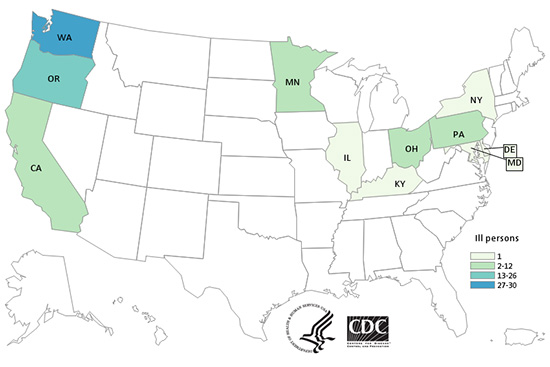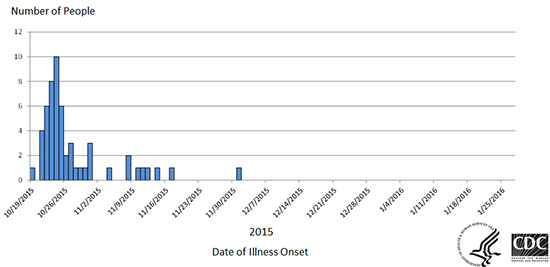2015 E. coli Outbreak Linked to Chipotle Mexican Grill Restaurants
Posted February 1, 2016 12:00 PM ET
These two outbreaks appear to be over. However, E. coli is still an important cause of human illness in the United States. More information about E. coli, and steps people can take to reduce their risk of infection, can be found on the CDC E. coli web page.
- Read the Advice to Food Industries & Consumers »
- These two outbreaks appear to be over. The most recent illness reported to CDC started on December 1, 2015.
- CDC, the U.S. Food and Drug Administration, the U.S. Department of Agriculture’s Food Safety and Inspection Service, and public health officials in several states investigated two separate outbreaks of Shiga toxin-producing Escherichia coli O26 (STEC O26) infections.
- In the initial, larger outbreak, 55 people infected with the outbreak strain of STEC O26 were reported from 11 states. Twenty-one ill people were hospitalized.
- In the second, smaller outbreak, 5 people infected with a different strain of STEC O26 were reported from 3 states. One ill person was hospitalized.
- There were no reports of hemolytic uremic syndrome and no deaths in either outbreak.
- Investigators used whole genome sequencing (WGS), an advanced laboratory technique, to get more detailed information about the DNA fingerprints of the STEC O26 bacteria that caused illness.
- Isolates tested from ill people in the second, smaller outbreak were not related genetically to isolates from ill people in the initial, larger outbreak.
- The epidemiologic evidence collected during this investigation suggested that a common meal item or ingredient served at Chipotle Mexican Grill restaurants was a likely source of both outbreaks. The investigation did not identify a specific food or ingredient linked to illness.
- Most ill people in these outbreaks ate many of the same food items at a Chipotle Mexican Grill restaurant. When a restaurant serves foods with several ingredients that are mixed or cooked together and then used in multiple menu items, it can be more difficult for epidemiologic studies to identity the specific ingredient that is contaminated.
- Testing of multiple food items collected from Chipotle restaurant locations did not identify STEC O26.
- A review of Chipotle’s distribution records by state and federal regulatory officials was unable to identify a single food item or ingredient that could explain either outbreak.
- Food industries are an important partner in making food safer for everyone. They can help stop outbreaks and lessen their impact by keeping detailed records to allow faster tracing of individual shipments of foods from source to destination and to help investigators identify what made people sick.
- Take action if you think you have a foodborne illness, such as talking to your healthcare provider, writing down what you ate in the week before you got sick, and answering questions about your illness when public health investigators contact you.
Introduction
CDC, the U.S. Food and Drug Administration, the U.S. Department of Agriculture’s Food Safety and Inspection Service, and public health officials in several states investigated two outbreaks of Shiga toxin-producing Escherichia coli O26 (STEC O26) infections.
Public health investigators used the PulseNet system to identify illnesses that were part of the outbreaks. PulseNet, the national subtyping network of public health and food regulatory agency laboratories, is coordinated by CDC. DNA fingerprinting is performed on E. coli bacteria isolated from ill people by using a technique called pulsed-field gel electrophoresis, or PFGE. PulseNet manages a national database of these DNA fingerprints to identify possible outbreaks. Two different, rare DNA fingerprints of STEC O26 were included in these investigations. Investigators also used whole genome sequencing (WGS), an advanced laboratory technique, to get more detailed information about the DNA fingerprints of the two STEC O26 strains that caused illness.
Summaries of the two outbreaks are provided in more detail below.
Initial, Larger Outbreak
The initial, larger outbreak was first detected by public health officials in Washington and Oregon through local foodborne disease surveillance. In late October 2015, officials in those states detected an increase in illness and after interviewing ill people, they determined that illness was likely linked to eating at multiple Chipotle Mexican Grill locations.
PFGE results from ill people in Washington and Oregon indicated that people were infected with a rare strain of STEC O26. A search of the PulseNet database identified illnesses in other states, and these ill people were added to the total case count.
A total of 55 people infected with the outbreak strain of STEC O26 were reported from 11 states. The majority of illnesses were reported from Washington and Oregon during October 2015. The number of ill people reported from each state was as follows: California (3), Delaware (1), Illinois (1), Kentucky (1), Maryland (1), Minnesota (2), New York (1), Ohio (3), Oregon (13), Pennsylvania (2), and Washington (27).
Among people for whom information was available, illnesses started on dates ranging from October 19, 2015 to December 1, 2015. Ill people ranged in age from 1 year to 94, with a median age of 21. Fifty-seven percent of ill people were female. Twenty-one (38%) people reported being hospitalized. There were no reports of hemolytic uremic syndrome and no deaths.
WGS was performed on 36 STEC O26 isolates from ill people in this outbreak, including isolates from ill people in states outside the Pacific Northwest. All 36 isolates were highly related genetically. This provided additional evidence that illnesses outside the Pacific Northwest were related to the earlier illnesses in Oregon and Washington.
Second, Smaller Outbreak
In December 2015, a second outbreak of a different, rare strain of STEC O26 was identified. A total of five people infected with this strain of STEC O26 were reported from three states. The number of ill people reported from each state was as follows: Kansas (1), North Dakota (1), and Oklahoma (3).
Among people for whom information was available, illnesses started on dates ranging from November 18, 2015 to November 26, 2015. Ill people ranged in age from 6 years to 25, with a median age of 22. Eighty percent of ill people were female. One (20%) person reported being hospitalized. There were no reports of hemolytic uremic syndrome and no deaths.
WGS was performed on four STEC O26 isolates from ill people in this outbreak. All four isolates were highly related genetically to each other, but they were not related to isolates from ill people in the initial, larger outbreak.
Investigation of the Outbreaks
The epidemiologic evidence collected during these investigations suggested that a common meal item or ingredient served at Chipotle Mexican Grill restaurants was a likely source of both outbreaks. The investigations did not identify a specific food or ingredient linked to illness in either outbreak.
State and local public health officials interviewed ill people to obtain information about foods they might have eaten and other exposures in the week before their illness started. In the initial, larger outbreak, 47 (87%) of 54 people interviewed reported eating at a Chipotle Mexican Grill restaurant. This included at least 17 different restaurant locations in 8 states. In the smaller outbreak, five (100%) of five people interviewed reported eating at a Chipotle Mexican Grill restaurant. All three ill people in Oklahoma ate at a single Chipotle location in that state. The ill person in North Dakota traveled to Kansas during the exposure period and ate at the same Chipotle location as the ill person in Kansas.
The data collected during interviews with ill people indicated that most ate a meal at a Chipotle Mexican Grill in the week before illness started, and they ate many of the same items. The Oregon and Washington Departments of Health conducted epidemiologic studies in the initial outbreak that compared foods eaten by ill and well people at Chipotle Mexican Grill. Those studies did not identify any specific food item or ingredient that could explain the outbreak. When a restaurant serves foods with several ingredients that are mixed or cooked together and then used in multiple menu items, it can be more difficult for epidemiologic studies to identify the specific ingredient that is contaminated.
Testing of multiple food items collected from Chipotle restaurant locations did not identify STEC O26.
A review of Chipotle’s distribution records by state and federal regulatory officials was unable to identify a single food item or ingredient that could explain illnesses in either outbreak. Food industries are an important partner in making food safer for everyone. They can help stop outbreaks and lessen their impact by keeping detailed records to allow faster tracing of individual shipments of foods from source to destination.

